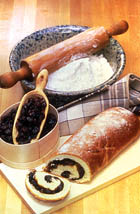
Beyond the familiar antioxidant vitamins A, C and E, recent research by the USDA Human Nutrition Research Center on Aging (Boston) is showing there is a whole class of powerful, protective antioxidants, called phytochemicals, being discovered in fruits and vegetables. These compounds may lower the risks of certain aging diseases by minimizing oxidative stress. The USDA has developed an assay, called ORAC (oxygen radical absorbance capacity), which quantifies the antioxidant activity in foods. Raisins have a high level of ORAC, 2830 ORAC units per 100g. Oranges have 750 ORAC units per 100g, and broccoli flowers have 890 ORAC units per 100g. The antioxidant activity can be attributed in part to the polyphenolic content of raisins. Karadeniz F, et al. (2000, Agric Food Chem, 48: 5343) found that raisins are a good dietary source of phenolic compounds such as flavonol glycosides and phenolic acids. According to a recent study, an average diet with five servings of fruits and vegetables would have an ORAC score of 1700 ORAC units. This amount of antioxidant activity could be provided by two ounces of raisins—a good reason to introduce raisins as a part of a varied diet.
To meet energy demands, some studies indicate that as much as 33% of the daily energy intake of children may come from snacking occasions which are often composed of just simple sugars and void of nutrients. The fat-free raisin is a nutrition energy source similar in energy density to popular energy bars on a calories-per-gram basis. In addition, the energy raisins provide is well utilized by the active body.
Active adults also benefit from eating raisins. A recent study showed that adults who ate raisins prior to and during intense workouts experienced lower or no DNA damage compared to the control group. According to Gene Spiller, Ph.D., who conducted the study, “this data leads one to believe that foods with a high ORAC value, such as California raisins, when used as a source of energy during strenuous exercise, protect most athletes from oxidative damage.” Oxidative damage is linked to a person's ability to fight chronic diseases, such as heart disease or certain types of cancer. Strenuous exercise can induce free radical formation in muscle and increase the need for antioxidants. The study found that athletes who ate approximately one cup of raisins before and during a triathlon were better protected from oxidative damage as measured in the urine than those who consumed a glucose drink of equivalent caloric value.
In addition to the fiber and essential vitamins and minerals raisins contribute to the diet, recent independent laboratory analysis sponsored by the California Raisin Marketing Board (CRMB) found that raisins are a good source of inulin. Inulin, a fiber-like carbohydrate, ferments in the colon and creates conditions that promote healthy colon cell growth and help prevent growth of abnormal cells that may lead to disease. Only a few other commonly eaten foods, such as onions, garlic and wheat are known to be good sources of inulin.
For more information:
California Raisin Marketing Board, Tom Payne
559-248-0287
info@raisins.org
www.calraisins.org
Sidebar: Does Your Formulation Good
Raisin-based ingredients appear in different forms, and provide benefits beyond eye-appeal and health.